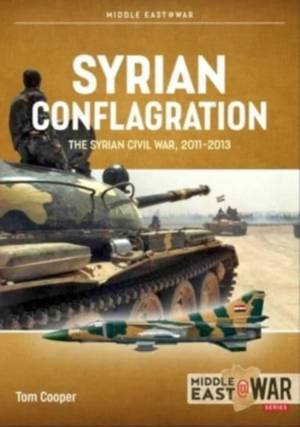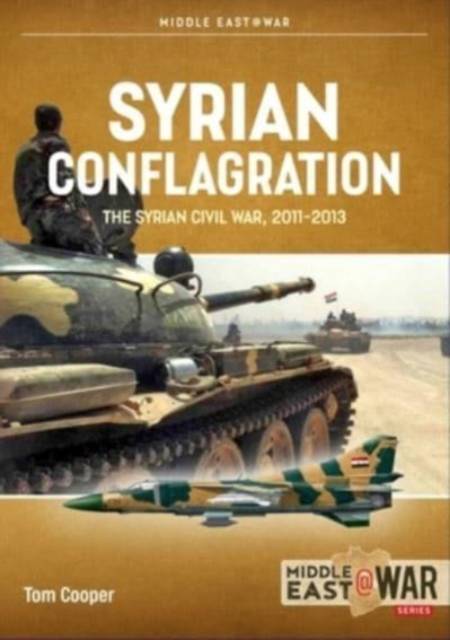
Bedankt voor het vertrouwen het afgelopen jaar! Om jou te bedanken bieden we GRATIS verzending (in België) aan op alles gedurende de hele maand januari.
- Afhalen na 1 uur in een winkel met voorraad
- Gratis thuislevering in België vanaf € 30
- Ruim aanbod met 7 miljoen producten
Bedankt voor het vertrouwen het afgelopen jaar! Om jou te bedanken bieden we GRATIS verzending (in België) aan op alles gedurende de hele maand januari.
- Afhalen na 1 uur in een winkel met voorraad
- Gratis thuislevering in België vanaf € 30
- Ruim aanbod met 7 miljoen producten
Zoeken
€ 27,95
+ 55 punten
Uitvoering
Omschrijving
The Syrian Civil War experienced an entirely unexpected transformation during its first two years. It started as unrest and a series of mass demonstrations within the Syrian population in the context of wider protest movements in the Middle East and North Africa in 2011, known as the Arab Spring. Unlike events in Egypt, Libya, Tunisia and Yemen, where oppressive governments were toppled by the end of that year, the government of Syria deployed the full force of its military, its intelligence apparatus, and paramilitary groups, launching an unprecedented crackdown that resulted in the arrest, detention and killing of many thousands. Despite its brutality, this effort backfired: it provoked mass desertions of the Syrian military and then an armed uprising.
The emerging insurgency was generally successful through 2012, although failing to capture Damascus, it secured more than half of Aleppo and Homs, the provincial capital of Raqqa, and nearly all of north-eastern and north-western Syria under its control. Although propped-up by economic and military support from the Islamic Republic of Iran and the Russian Federation, the government of Syria was nearing the brink of collapse during the first half of 2013 when, prompted by Tehran, Hezbollah - a Shi'a Islamic militant group and political party from Lebanon - entered the conflict on its side. Soon after, Hezbollah was reinforced by significant contingents of Iranian-sponsored Shi'a from Iraq, Lebanon and elsewhere, followed by volunteers from Iran, including crack units of the Islamic Revolutionary Guards Corps. Meanwhile, already split along the lines of Syria's complex demography, much of the insurgency transformed from a secular and non-sectarian movement into proxies of various foreign powers, foremost Saudi Arabia and Qatar, but also Turkey and Kuwait. Furthermore, foreign Jihadists motivated by al-Qaida joined the fray, aiming to establish an Islamist state and clandestinely cooperating with the government, they fell upon the insurgency.
Thus, an extremely complex conflict - which then not only spilled over the border into Lebanon, but had a major impact upon Iranian-Saudi relations, and relations between the West, Iran and a number of Arab countries - came into being, the outcome of which was anything but predictable.
This revised edition of Syrian Conflagration draws on extensive research, including first-hand accounts, and provides a compelling overview of the first three years of the ongoing conflict in Syria. The book features 120 full-color photographs, 27 full-color artworks and four color maps.
The emerging insurgency was generally successful through 2012, although failing to capture Damascus, it secured more than half of Aleppo and Homs, the provincial capital of Raqqa, and nearly all of north-eastern and north-western Syria under its control. Although propped-up by economic and military support from the Islamic Republic of Iran and the Russian Federation, the government of Syria was nearing the brink of collapse during the first half of 2013 when, prompted by Tehran, Hezbollah - a Shi'a Islamic militant group and political party from Lebanon - entered the conflict on its side. Soon after, Hezbollah was reinforced by significant contingents of Iranian-sponsored Shi'a from Iraq, Lebanon and elsewhere, followed by volunteers from Iran, including crack units of the Islamic Revolutionary Guards Corps. Meanwhile, already split along the lines of Syria's complex demography, much of the insurgency transformed from a secular and non-sectarian movement into proxies of various foreign powers, foremost Saudi Arabia and Qatar, but also Turkey and Kuwait. Furthermore, foreign Jihadists motivated by al-Qaida joined the fray, aiming to establish an Islamist state and clandestinely cooperating with the government, they fell upon the insurgency.
Thus, an extremely complex conflict - which then not only spilled over the border into Lebanon, but had a major impact upon Iranian-Saudi relations, and relations between the West, Iran and a number of Arab countries - came into being, the outcome of which was anything but predictable.
This revised edition of Syrian Conflagration draws on extensive research, including first-hand accounts, and provides a compelling overview of the first three years of the ongoing conflict in Syria. The book features 120 full-color photographs, 27 full-color artworks and four color maps.
Specificaties
Betrokkenen
- Auteur(s):
- Uitgeverij:
Inhoud
- Aantal bladzijden:
- 96
- Taal:
- Engels
- Reeks:
Eigenschappen
- Productcode (EAN):
- 9781915070814
- Verschijningsdatum:
- 20/06/2022
- Uitvoering:
- Paperback
- Formaat:
- Trade paperback (VS)
- Afmetingen:
- 208 mm x 295 mm
- Gewicht:
- 385 g

Alleen bij Standaard Boekhandel
+ 55 punten op je klantenkaart van Standaard Boekhandel
Beoordelingen
We publiceren alleen reviews die voldoen aan de voorwaarden voor reviews. Bekijk onze voorwaarden voor reviews.









